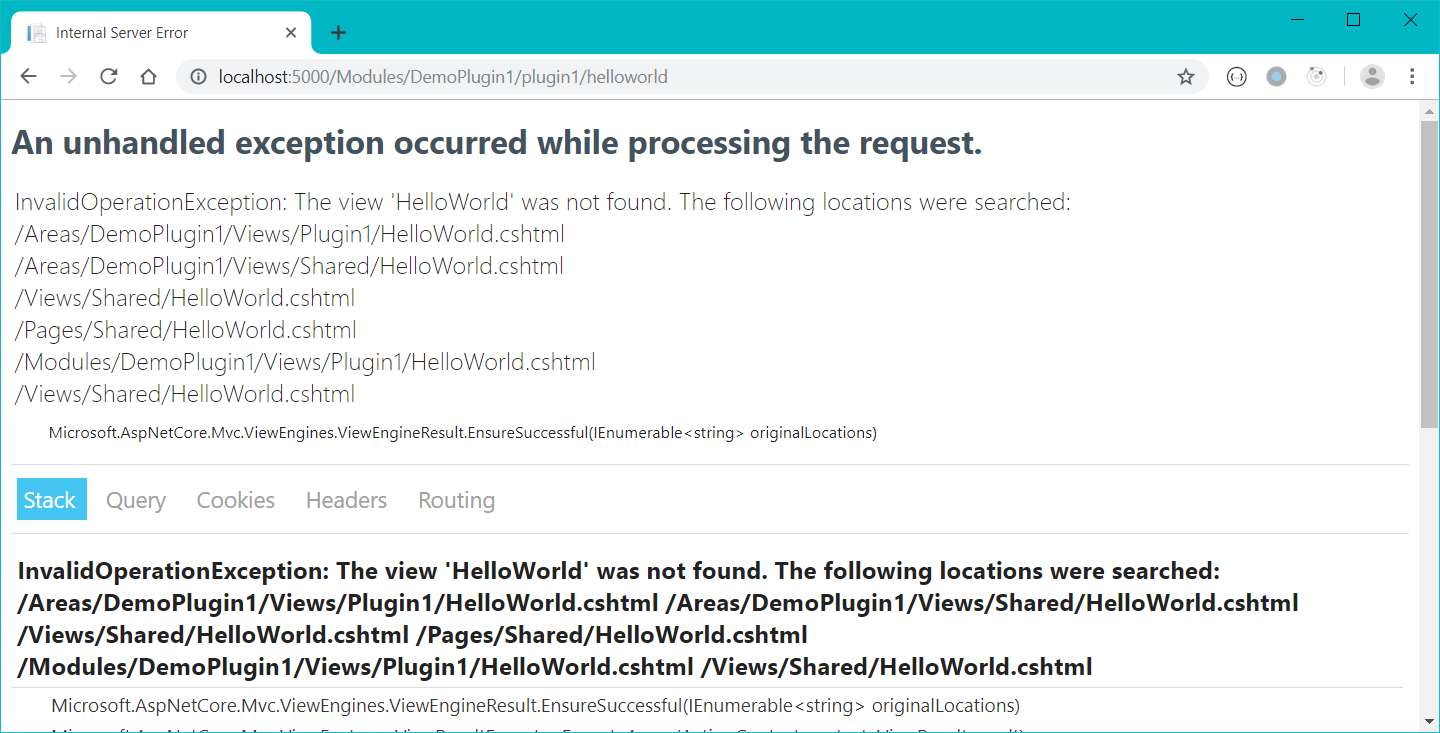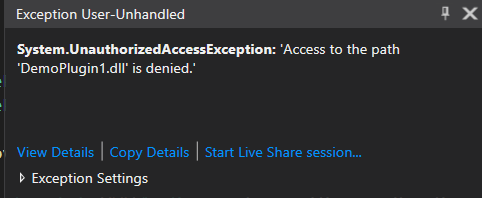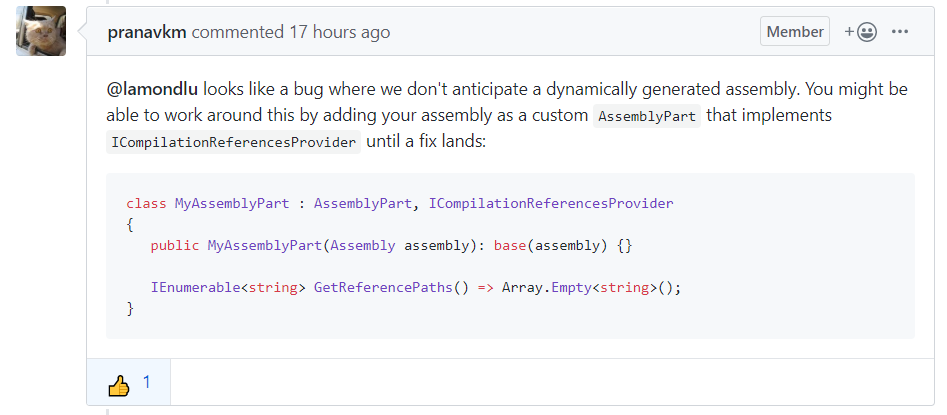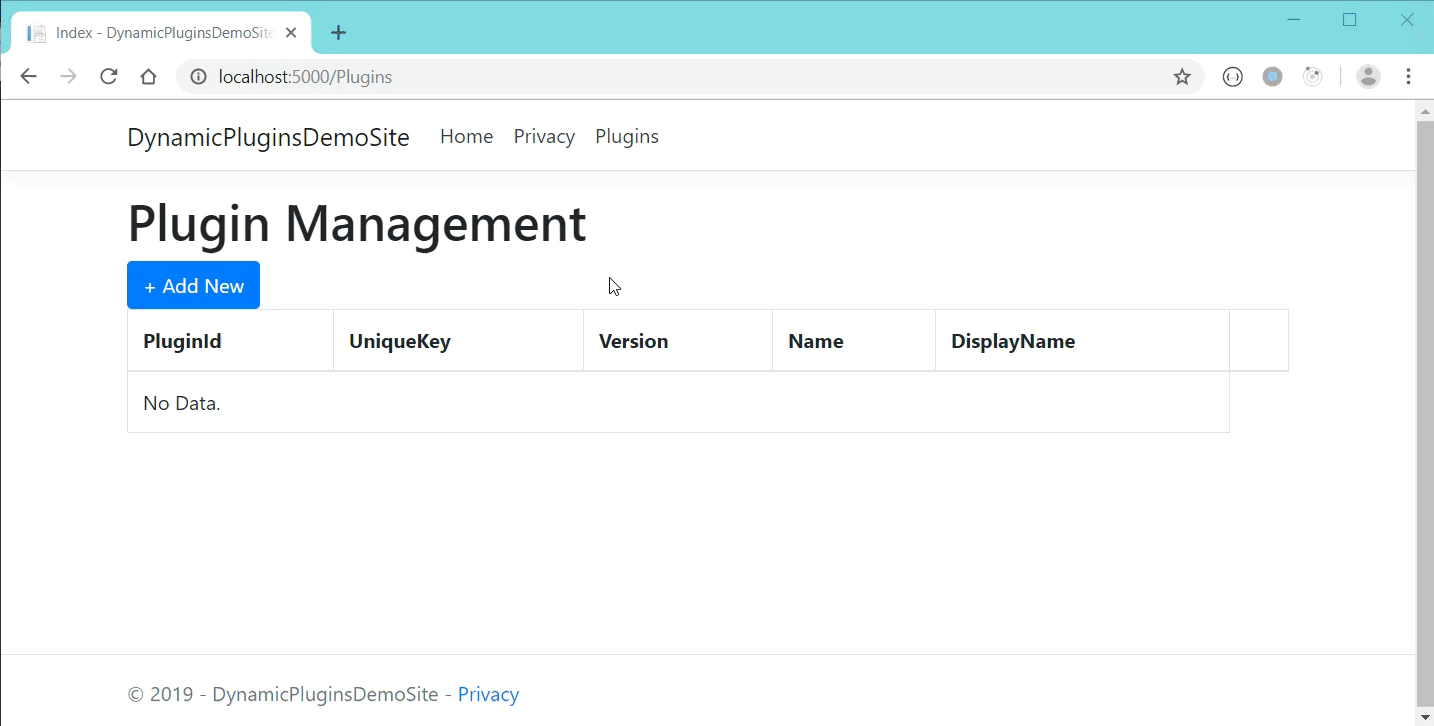从零开始实现ASP.NET Core MVC的插件式开发(五) - 插件的删除和升级
标题:从零开始实现ASP.NET Core MVC的插件式开发(五) - 使用AssemblyLoadContext实现插件的升级和删除
作者:Lamond Lu
地址:https://www.cnblogs.com/lwqlun/p/11395828.html
源代码:https://github.com/lamondlu/Mystique

前景回顾:
- 从零开始实现ASP.NET Core MVC的插件式开发(一) - 使用Application Part动态加载控制器和视图
- 从零开始实现ASP.NET Core MVC的插件式开发(二) - 如何创建项目模板
- 从零开始实现ASP.NET Core MVC的插件式开发(三) - 如何在运行时启用组件
- 从零开始实现ASP.NET Core MVC的插件式开发(四) - 插件安装
简介
在上一篇中,我为大家讲解了如何实现插件的安装,在文章的最后,留下了两个待解决的问题。
- .NET Core 2.2中不能实现运行时删除插件
- .NET Core 2.2中不能实现运行时升级插件
其实这2个问题归根结底其实都是一个问题,就是插件程序集被占用,不能在运行时更换程序集。在本篇中,我将分享一下我是如何一步一步解决这个问题的,其中也绕了不少弯路,查阅过资料,在.NET Core官方提过Bug,几次差点想放弃了,不过最终是找到一个可行的方案。
.NET Core 2.2的遗留问题
程序集被占用的原因
回顾一下,我们之前加载插件程序集时所有使用的代码。
var provider = services.BuildServiceProvider();using (var scope = provider.CreateScope()){var unitOfWork = scope.ServiceProvider.GetService<IUnitOfWork>();var allEnabledPlugins = unitOfWork.PluginRepository.GetAllEnabledPlugins();foreach (var plugin in allEnabledPlugins){var moduleName = plugin.Name;var assembly = Assembly.LoadFile($"{AppDomain.CurrentDomain.BaseDirectory}Modules\\{moduleName}\\{moduleName}.dll");var controllerAssemblyPart = new AssemblyPart(assembly);mvcBuilders.PartManager.ApplicationParts.Add(controllerAssemblyPart);}}
这里我们使用了Assembly.LoadFile方法加载了插件程序集。 在.NET中使用Assembly.LoadFile方法加载的程序集会被自动锁定,不能执行任何转移,删除等造作,所以这就给我们删除和升级插件造成了很大困难。
PS: 升级插件需要覆盖已加载的插件程序集,由于程序集锁定,所以覆盖操作不能成功。
使用AssemblyLoadContext
在.NET Framework中,如果遇到这个问题,常用的解决方案是使用AppDomain类来实现插件热插拔,但是在.NET Core中没有AppDomain类。不过经过查阅,.NET Core 2.0之后引入了一个AssemblyLoadContext类来替代.NET Freamwork中的AppDomain。本以为使用它就能解决当前程序集占用的问题,结果没想到.NET Core 2.x版本提供的AssemblyLoadContext没有提供Unload方法来释放加载的程序集,只有在.NET Core 3.0版本中才为AssemblyLoadContext类添加了Unload方法。
相关链接:
升级.NET Core 3.0 Preview 8
因此,为了完成插件的删除和升级功能,我将整个项目升级到了最新的.NET Core 3.0 Preview 8版本。
这里.NET Core 2.2升级到.NET Core 3.0有一点需要注意的问题。
在.NET Core 2.2中默认启用了Razor视图的运行时编译,简单点说就是.NET Core 2.2中自动启用了读取原始的Razor视图文件,并编译视图的功能。这就是我们在第三章和第四章中的实现方法,每个插件文件最终都放置在了一个Modules目录中,每个插件既有包含Controller/Action的程序集,又有对应的原始Razor视图目录Views,在.NET Core 2.2中当我们在运行时启用一个组件之后,对应的Views可以自动加载。
The files tree is:=================|__ DynamicPlugins.Core.dll|__ DynamicPlugins.Core.pdb|__ DynamicPluginsDemoSite.deps.json|__ DynamicPluginsDemoSite.dll|__ DynamicPluginsDemoSite.pdb|__ DynamicPluginsDemoSite.runtimeconfig.dev.json|__ DynamicPluginsDemoSite.runtimeconfig.json|__ DynamicPluginsDemoSite.Views.dll|__ DynamicPluginsDemoSite.Views.pdb|__ Modules|__ DemoPlugin1|__ DemoPlugin1.dll|__ Views|__ Plugin1|__ HelloWorld.cshtml|__ _ViewStart.cshtml
但是在.NET Core 3.0中,Razor视图的运行时编译需要引入程序集Microsoft.AspNetCore.Mvc.Razor.RuntimeCompilation。并且在程序启动时,需要启动运行时编译的功能。
public void ConfigureServices(IServiceCollection services){...var mvcBuilders = services.AddMvc().AddRazorRuntimeCompilation();...}
如果没有启用Razor视图的运行时编译,程序访问插件视图的时候,就会报错,提示视图找不到。

使用.NET Core 3.0的AssemblyLoadContext加载程序集
这里为了创建一个可回收的程序集加载上下文,我们首先基于AssemblyLoadcontext创建一个CollectibleAssemblyLoadContext类。其中我们将IsCollectible属性通过父类构造函数,将其设置为true。
public class CollectibleAssemblyLoadContext: AssemblyLoadContext{public CollectibleAssemblyLoadContext(): base(isCollectible: true){}protected override Assembly Load(AssemblyName name){return null;}}
在整个插件加载上下文的设计上,每个插件都使用一个单独的CollectibleAssemblyLoadContext来加载,所有插件的CollectibleAssemblyLoadContext都放在一个PluginsLoadContext对象中。
相关代码: PluginsLoadContexts.cs
public static class PluginsLoadContexts{private static Dictionary<string, CollectibleAssemblyLoadContext>_pluginContexts = null;static PluginsLoadContexts(){_pluginContexts = new Dictionary<string, CollectibleAssemblyLoadContext>();}public static bool Any(string pluginName){return _pluginContexts.ContainsKey(pluginName);}public static void RemovePluginContext(string pluginName){if (_pluginContexts.ContainsKey(pluginName)){_pluginContexts[pluginName].Unload();_pluginContexts.Remove(pluginName);}}public static CollectibleAssemblyLoadContext GetContext(string pluginName){return _pluginContexts[pluginName];}public static void AddPluginContext(string pluginName,CollectibleAssemblyLoadContext context){_pluginContexts.Add(pluginName, context);}}
代码解释:
- 当加载插件的时候,我们需要将当前插件的程序集加载上下文放到
_pluginContexts字典中。字典的key是插件的名称,字典的value是插件的程序集加载上下文。 - 当移除一个插件的时候,我们需要使用
Unload方法,来释放当前的程序集加载上下文。
在完成以上代码之后,我们更改程序启动和启用组件的代码,因为这两部分都需要将插件程序集加载到CollectibleAssemblyLoadContext中。
Startup.cs
var provider = services.BuildServiceProvider();using (var scope = provider.CreateScope()){var option = scope.ServiceProvider.GetService<MvcRazorRuntimeCompilationOptions>();var unitOfWork = scope.ServiceProvider.GetService<IUnitOfWork>();var allEnabledPlugins = unitOfWork.PluginRepository.GetAllEnabledPlugins();foreach (var plugin in allEnabledPlugins){var context = new CollectibleAssemblyLoadContext();var moduleName = plugin.Name;var filePath = $"{AppDomain.CurrentDomain.BaseDirectory}Modules\\{moduleName}\\{moduleName}.dll";var assembly = context.LoadFromAssemblyPath(filePath);var controllerAssemblyPart = new AssemblyPart(assembly);mvcBuilders.PartManager.ApplicationParts.Add(controllerAssemblyPart);PluginsLoadContexts.AddPluginContext(plugin.Name, context);}}
PluginsController.cs
public IActionResult Enable(Guid id){var module = _pluginManager.GetPlugin(id);if (!PluginsLoadContexts.Any(module.Name)){var context = new CollectibleAssemblyLoadContext();_pluginManager.EnablePlugin(id);var moduleName = module.Name;var filePath = $"{AppDomain.CurrentDomain.BaseDirectory}Modules\\{moduleName}\\{moduleName}.dll";context.var assembly = context.LoadFromAssemblyPath(filePath);var controllerAssemblyPart = new AssemblyPart(assembly);_partManager.ApplicationParts.Add(controllerAssemblyPart);MyActionDescriptorChangeProvider.Instance.HasChanged = true;MyActionDescriptorChangeProvider.Instance.TokenSource.Cancel();PluginsLoadContexts.AddPluginContext(module.Name, context);}else{var context = PluginsLoadContexts.GetContext(module.Name);var controllerAssemblyPart = new AssemblyPart(context.Assemblies.First());_partManager.ApplicationParts.Add(controllerAssemblyPart);_pluginManager.EnablePlugin(id);MyActionDescriptorChangeProvider.Instance.HasChanged = true;MyActionDescriptorChangeProvider.Instance.TokenSource.Cancel();}return RedirectToAction("Index");}
意外结果
完成以上代码之后,我立刻尝试了删除程序集的操作,但是得到的结果却不是我想要的。
虽然.NET Core 3.0为AssemblyLoadContext提供了Unload方法,但是调用之后, 你依然会得到一个文件被占用的错误

暂时不知道这是不是.NET Core 3.0的bug, 还是功能就是这么设计的,反正感觉这条路是走不通了,折腾了一天,在网上找了好多方案,但是都不能解决这个问题。
就在快放弃的时候,突然发现AssemblyLoadContext类提供了另外一种加载程序集的方式LoadFromStream。
改用LoadFromStream加载程序集
看到LoadFromStream方法之后,我的第一思路就是可以使用FileStream加载插件程序集,然后将获得的文件流传给LoadFromStream方法,并在文件加载完毕之后,释放掉这个FileStream对象。
根据以上思路,我将加载程序集的方法修改如下
PS: Enable方法的修改方式类似,这里我就不重复写了。
var provider = services.BuildServiceProvider();using (var scope = provider.CreateScope()){var option = scope.ServiceProvider.GetService<MvcRazorRuntimeCompilationOptions>();var unitOfWork = scope.ServiceProvider.GetService<IUnitOfWork>();var allEnabledPlugins = unitOfWork.PluginRepository.GetAllEnabledPlugins();foreach (var plugin in allEnabledPlugins){var context = new CollectibleAssemblyLoadContext();var moduleName = plugin.Name;var filePath = $"{AppDomain.CurrentDomain.BaseDirectory}Modules\\{moduleName}\\{moduleName}.dll";_presetReferencePaths.Add(filePath);using (var fs = new FileStream(filePath, FileMode.Open)){var assembly = context.LoadFromStream(fs);var controllerAssemblyPart = new AssemblyPart(assembly);mvcBuilders.PartManager.ApplicationParts.Add(controllerAssemblyPart);PluginsLoadContexts.AddPluginContext(plugin.Name, context);}}}
修改之后,我又试了一下删除插件的代码,果然成功删除了。
"Empty path name is not legal. "问题
就在我认为功能已经全部完成之后,我又重新安装了删除的插件,尝试访问插件中的controller/action, 结果得到了意想不到的错误,插件的中包含的页面打不开了。
fail: Microsoft.AspNetCore.Diagnostics.ExceptionHandlerMiddleware[1]An unhandled exception has occurred while executing the request.System.ArgumentException: Empty path name is not legal. (Parameter 'path')at System.IO.FileStream..ctor(String path, FileMode mode, FileAccess access, FileShare share, Int32 bufferSize, FileOptions options)at Microsoft.AspNetCore.Mvc.Razor.RuntimeCompilation.RazorReferenceManager.CreateMetadataReference(String path)at System.Linq.Enumerable.SelectListIterator`2.ToList()at System.Linq.Enumerable.ToList[TSource](IEnumerable`1 source)at Microsoft.AspNetCore.Mvc.Razor.RuntimeCompilation.RazorReferenceManager.GetCompilationReferences()at System.Threading.LazyInitializer.EnsureInitializedCore[T](T& target, Boolean& initialized, Object& syncLock, Func`1 valueFactory)at System.Threading.LazyInitializer.EnsureInitialized[T](T& target, Boolean& initialized, Object& syncLock, Func`1 valueFactory)at Microsoft.AspNetCore.Mvc.Razor.RuntimeCompilation.RazorReferenceManager.get_CompilationReferences()at Microsoft.AspNetCore.Mvc.Razor.RuntimeCompilation.LazyMetadataReferenceFeature.get_References()at Microsoft.CodeAnalysis.Razor.CompilationTagHelperFeature.GetDescriptors()at Microsoft.AspNetCore.Razor.Language.DefaultRazorTagHelperBinderPhase.ExecuteCore(RazorCodeDocument codeDocument)at Microsoft.AspNetCore.Razor.Language.RazorEnginePhaseBase.Execute(RazorCodeDocument codeDocument)at Microsoft.AspNetCore.Razor.Language.DefaultRazorEngine.Process(RazorCodeDocument document)at Microsoft.AspNetCore.Razor.Language.DefaultRazorProjectEngine.ProcessCore(RazorCodeDocument codeDocument)at Microsoft.AspNetCore.Razor.Language.RazorProjectEngine.Process(RazorProjectItem projectItem)at Microsoft.AspNetCore.Mvc.Razor.RuntimeCompilation.RuntimeViewCompiler.CompileAndEmit(String relativePath)at Microsoft.AspNetCore.Mvc.Razor.RuntimeCompilation.RuntimeViewCompiler.OnCacheMiss(String normalizedPath)--- End of stack trace from previous location where exception was thrown ---at Microsoft.AspNetCore.Mvc.Razor.Compilation.DefaultRazorPageFactoryProvider.CreateFactory(String relativePath)at Microsoft.AspNetCore.Mvc.Razor.RazorViewEngine.CreateCacheResult(HashSet`1 expirationTokens, String relativePath, Boolean isMainPage)at Microsoft.AspNetCore.Mvc.Razor.RazorViewEngine.OnCacheMiss(ViewLocationExpanderContext expanderContext, ViewLocationCacheKey cacheKey)at Microsoft.AspNetCore.Mvc.Razor.RazorViewEngine.LocatePageFromViewLocations(ActionContext actionContext, String pageName, Boolean isMainPage)at Microsoft.AspNetCore.Mvc.Razor.RazorViewEngine.FindView(ActionContext context, String viewName, Boolean isMainPage)at Microsoft.AspNetCore.Mvc.ViewEngines.CompositeViewEngine.FindView(ActionContext context, String viewName, Boolean isMainPage)at Microsoft.AspNetCore.Mvc.ViewFeatures.ViewResultExecutor.FindView(ActionContext actionContext, ViewResult viewResult)at Microsoft.AspNetCore.Mvc.ViewFeatures.ViewResultExecutor.ExecuteAsync(ActionContext context, ViewResult result)at Microsoft.AspNetCore.Mvc.ViewResult.ExecuteResultAsync(ActionContext context)at Microsoft.AspNetCore.Mvc.Infrastructure.ResourceInvoker.<InvokeNextResultFilterAsync>g__Awaited|29_0[TFilter,TFilterAsync](ResourceInvoker invoker, Task lastTask, State next, Scope scope, Object state, Boolean isCompleted)at Microsoft.AspNetCore.Mvc.Infrastructure.ResourceInvoker.Rethrow(ResultExecutedContextSealed context)at Microsoft.AspNetCore.Mvc.Infrastructure.ResourceInvoker.ResultNext[TFilter,TFilterAsync](State& next, Scope& scope, Object& state, Boolean& isCompleted)at Microsoft.AspNetCore.Mvc.Infrastructure.ResourceInvoker.InvokeResultFilters()--- End of stack trace from previous location where exception was thrown ---at Microsoft.AspNetCore.Mvc.Infrastructure.ResourceInvoker.<InvokeNextResourceFilter>g__Awaited|24_0(ResourceInvoker invoker, Task lastTask, State next, Scope scope, Object state, Boolean isCompleted)at Microsoft.AspNetCore.Mvc.Infrastructure.ResourceInvoker.Rethrow(ResourceExecutedContextSealed context)at Microsoft.AspNetCore.Mvc.Infrastructure.ResourceInvoker.Next(State& next, Scope& scope, Object& state, Boolean& isCompleted)at Microsoft.AspNetCore.Mvc.Infrastructure.ResourceInvoker.InvokeFilterPipelineAsync()--- End of stack trace from previous location where exception was thrown ---at Microsoft.AspNetCore.Mvc.Infrastructure.ResourceInvoker.<InvokeAsync>g__Awaited|17_0(ResourceInvoker invoker, Task task, IDisposable scope)at Microsoft.AspNetCore.Routing.EndpointMiddleware.<Invoke>g__AwaitRequestTask|6_0(Endpoint endpoint, Task requestTask, ILogger logger)at Microsoft.AspNetCore.Routing.EndpointRoutingMiddleware.SetRoutingAndContinue(HttpContext httpContext)at Microsoft.AspNetCore.Diagnostics.ExceptionHandlerMiddleware.<Invoke>g__Awaited|6_0(ExceptionHandlerMiddleware middleware, HttpContext context, Task task)
这个文件路径非法的错误让我感觉很奇怪,为什么会有这种问题呢?与之前的代码的不同之处只有一个地方,就是从LoadFromAssemblyPath改为了LoadFromStream。
为了弄清这个问题,我clone了最新的.NET Core 3.0 Preview 8源代码,发现了在 .NET Core运行时编译视图的时候,会调用如下方法。
RazorReferenceManager.cs
internal IEnumerable<string> GetReferencePaths(){var referencePaths = new List<string>();foreach (var part in _partManager.ApplicationParts){if (part is ICompilationReferencesProvider compilationReferenceProvider){referencePaths.AddRange(compilationReferenceProvider.GetReferencePaths());}else if (part is AssemblyPart assemblyPart){referencePaths.AddRange(assemblyPart.GetReferencePaths());}}referencePaths.AddRange(_options.AdditionalReferencePaths);return referencePaths;}
这段代码意思是根据当前加载程序集的所在位置,来发现对应视图。
那么问题就显而易见了,我们之前用LoadFromAssemblyPath加载程序集,程序集的文件位置被自动记录下来,但是我们改用LoadFromStream之后,所需的文件位置信息丢失了,是一个空字符串,所以.NET Core在尝试加载视图的时候,遇到空字符串,抛出了一个非法路径的错误。
其实这里的方法很好改,只需要将空字符串的路径排除掉即可。
internal IEnumerable<string> GetReferencePaths(){var referencePaths = new List<string>();foreach (var part in _partManager.ApplicationParts){if (part is ICompilationReferencesProvider compilationReferenceProvider){referencePaths.AddRange(compilationReferenceProvider.GetReferencePaths());}else if (part is AssemblyPart assemblyPart){referencePaths.AddRange(assemblyPart.GetReferencePaths().Where(o => !string.IsNullOrEmpty(o));}}referencePaths.AddRange(_options.AdditionalReferencePaths);return referencePaths;}
但是由于不清楚会不会导致其他问题,所以我没有采取这种方法,我将这个问题作为一个Bug提交到了官方。
没想到仅仅8小时,就得到官方的解决方案。

这段意思是说ASP.NET Core暂时不支持动态加载程序集,如果要在当前版本实现功能,需要自己实现一个AssemblyPart类, 在获取程序集路径的时候,返回空集合而不是空字符串。
PS: 官方已经将这个问题放到了.NET 5 Preview 1中,相信.NET 5中会得到真正的解决。
根据官方的方案,Startup.cs文件的最终版本
public class MyAssemblyPart : AssemblyPart, ICompilationReferencesProvider{public MyAssemblyPart(Assembly assembly) : base(assembly) { }public IEnumerable<string> GetReferencePaths() => Array.Empty<string>();}public static class AdditionalReferencePathHolder{public static IList<string> AdditionalReferencePaths = new List<string>();}public class Startup{public IList<string> _presets = new List<string>();public Startup(IConfiguration configuration){Configuration = configuration;}public IConfiguration Configuration { get; }// This method gets called by the runtime. Use this method to add services to the container.public void ConfigureServices(IServiceCollection services){services.AddOptions();services.Configure<ConnectionStringSetting>(Configuration.GetSection("ConnectionStringSetting"));services.AddScoped<IPluginManager, PluginManager>();services.AddScoped<IUnitOfWork, UnitOfWork>();var mvcBuilders = services.AddMvc().AddRazorRuntimeCompilation(o =>{foreach (var item in _presets){o.AdditionalReferencePaths.Add(item);}AdditionalReferencePathHolder.AdditionalReferencePaths = o.AdditionalReferencePaths;});services.Configure<RazorViewEngineOptions>(o =>{o.AreaViewLocationFormats.Add("/Modules/{2}/Views/{1}/{0}" + RazorViewEngine.ViewExtension);o.AreaViewLocationFormats.Add("/Views/Shared/{0}.cshtml");});services.AddSingleton<IActionDescriptorChangeProvider>(MyActionDescriptorChangeProvider.Instance);services.AddSingleton(MyActionDescriptorChangeProvider.Instance);var provider = services.BuildServiceProvider();using (var scope = provider.CreateScope()){var option = scope.ServiceProvider.GetService<MvcRazorRuntimeCompilationOptions>();var unitOfWork = scope.ServiceProvider.GetService<IUnitOfWork>();var allEnabledPlugins = unitOfWork.PluginRepository.GetAllEnabledPlugins();foreach (var plugin in allEnabledPlugins){var context = new CollectibleAssemblyLoadContext();var moduleName = plugin.Name;var filePath = $"{AppDomain.CurrentDomain.BaseDirectory}Modules\\{moduleName}\\{moduleName}.dll";_presets.Add(filePath);using (var fs = new FileStream(filePath, FileMode.Open)){var assembly = context.LoadFromStream(fs);var controllerAssemblyPart = new MyAssemblyPart(assembly);mvcBuilders.PartManager.ApplicationParts.Add(controllerAssemblyPart);PluginsLoadContexts.AddPluginContext(plugin.Name, context);}}}}public void Configure(IApplicationBuilder app, IWebHostEnvironment env){if (env.IsDevelopment()){app.UseDeveloperExceptionPage();}else{app.UseExceptionHandler("/Home/Error");}app.UseStaticFiles();app.UseRouting();app.UseEndpoints(routes =>{routes.MapControllerRoute(name: "Customer",pattern: "{controller=Home}/{action=Index}/{id?}");routes.MapControllerRoute(name: "Customer",pattern: "Modules/{area}/{controller=Home}/{action=Index}/{id?}");});}}
插件删除和升级的代码
解决了程序集占用问题之后,我们就可以开始编写删除/升级插件的代码了。
删除插件
如果要删除一个插件,我们需要完成以下几个步骤
- 删除组件记录
- 删除组件迁移的表结构
- 移除加载过的ApplicationPart
- 刷新Controller/Action
- 移除组件对应的程序集加载上下文
- 删除组件文件
根据这个步骤,我编写了一个Delete方法,代码如下:
public IActionResult Delete(Guid id){var module = _pluginManager.GetPlugin(id);_pluginManager.DisablePlugin(id);_pluginManager.DeletePlugin(id);var moduleName = module.Name;var matchedItem = _partManager.ApplicationParts.FirstOrDefault(p =>p.Name == moduleName);if (matchedItem != null){_partManager.ApplicationParts.Remove(matchedItem);matchedItem = null;}MyActionDescriptorChangeProvider.Instance.HasChanged = true;MyActionDescriptorChangeProvider.Instance.TokenSource.Cancel();PluginsLoadContexts.RemovePluginContext(module.Name);var directory = new DirectoryInfo($"{AppDomain.CurrentDomain.BaseDirectory}Modules/{module.Name}");directory.Delete(true);return RedirectToAction("Index");}
升级插件
对于升级插件的代码,我将它和新增插件的代码放在了一起
public void AddPlugins(PluginPackage pluginPackage){var existedPlugin = _unitOfWork.PluginRepository.GetPlugin(pluginPackage.Configuration.Name);if (existedPlugin == null){InitializePlugin(pluginPackage);}else if (new DomainModel.Version(pluginPackage.Configuration.Version) > new DomainModel.Version(existedPlugin.Version)){UpgradePlugin(pluginPackage, existedPlugin);}else{DegradePlugin(pluginPackage);}}private void InitializePlugin(PluginPackage pluginPackage){var plugin = new DTOs.AddPluginDTO{Name = pluginPackage.Configuration.Name,DisplayName = pluginPackage.Configuration.DisplayName,PluginId = Guid.NewGuid(),UniqueKey = pluginPackage.Configuration.UniqueKey,Version = pluginPackage.Configuration.Version};_unitOfWork.PluginRepository.AddPlugin(plugin);_unitOfWork.Commit();var versions = pluginPackage.GetAllMigrations(_connectionString);foreach (var version in versions){version.MigrationUp(plugin.PluginId);}pluginPackage.SetupFolder();}public void UpgradePlugin(PluginPackage pluginPackage, PluginViewModel oldPlugin){_unitOfWork.PluginRepository.UpdatePluginVersion(oldPlugin.PluginId,pluginPackage.Configuration.Version);_unitOfWork.Commit();var migrations = pluginPackage.GetAllMigrations(_connectionString);var pendingMigrations = migrations.Where(p => p.Version > oldPlugin.Version);foreach (var migration in pendingMigrations){migration.MigrationUp(oldPlugin.PluginId);}pluginPackage.SetupFolder();}public void DegradePlugin(PluginPackage pluginPackage){throw new NotImplementedException();}
代码解释:
这里我首先判断了当前插件包和已安装版本的版本差异
- 如果系统没有安装过当前插件,就安装插件
- 如果当前插件包的版本比已安装的版本高,就升级插件
- 如果当前插件包的版本比已安装的版本低,就降级插件(现实中这种情况不多)
InitializePlugin是用来加载新组件的,它的内容就是之前的新增插件方法UpgradePlugin是用来升级组件的,当我们升级一个组件的时候,我们需要做一下几个事情- 升级组件版本
- 做最新版本组件的脚本迁移
- 使用最新程序包覆盖老程序包
DegradePlugin是用来降级组件的,由于篇幅问题,我就不详细写了,大家可以自行填补。
最终效果

总结
本篇中,我为大家演示如果使用.NET Core 3.0的AssemblyLoadContext来解决已加载程序集占用的问题,以此实现了插件的升级和降级。本篇的研究时间较长,因为中间出现的问题确实太多了,没有什么可以复用的方案,我也不知道是不是第一个在.NET Core中这么尝试的。不过结果还算好,想实现的功能最终还是做出来了。后续呢,这个项目会继续添加新的功能,希望大家多多支持。
从零开始实现ASP.NET Core MVC的插件式开发(五) - 插件的删除和升级的更多相关文章
- 从零开始实现ASP.NET Core MVC的插件式开发(一) - 使用ApplicationPart动态加载控制器和视图
标题:从零开始实现ASP.NET Core MVC的插件式开发(一) - 使用Application Part动态加载控制器和视图 作者:Lamond Lu 地址:http://www.cnblogs ...
- 从零开始实现ASP.NET Core MVC的插件式开发(二) - 如何创建项目模板
标题:从零开始实现ASP.NET Core MVC的插件式开发(二) - 如何创建项目模板 作者:Lamond Lu 地址:https://www.cnblogs.com/lwqlun/p/11155 ...
- 从零开始实现ASP.NET Core MVC的插件式开发(三) - 如何在运行时启用组件
标题:从零开始实现ASP.NET Core MVC的插件式开发(三) - 如何在运行时启用组件 作者:Lamond Lu 地址:https://www.cnblogs.com/lwqlun/p/112 ...
- 从零开始实现ASP.NET Core MVC的插件式开发(四) - 插件安装
标题:从零开始实现ASP.NET Core MVC的插件式开发(四) - 插件安装 作者:Lamond Lu 地址:https://www.cnblogs.com/lwqlun/p/11260750. ...
- 从零开始实现ASP.NET Core MVC的插件式开发(六) - 如何加载插件引用
标题:从零开始实现ASP.NET Core MVC的插件式开发(六) - 如何加载插件引用. 作者:Lamond Lu 地址:https://www.cnblogs.com/lwqlun/p/1171 ...
- 从零开始实现ASP.NET Core MVC的插件式开发(七) - 近期问题汇总及部分解决方案
标题:从零开始实现ASP.NET Core MVC的插件式开发(七) - 问题汇总及部分解决方案 作者:Lamond Lu 地址:https://www.cnblogs.com/lwqlun/p/12 ...
- 从零开始实现ASP.NET Core MVC的插件式开发(八) - Razor视图相关问题及解决方案
标题:从零开始实现ASP.NET Core MVC的插件式开发(八) - Razor视图相关问题及解决方案 作者:Lamond Lu 地址:https://www.cnblogs.com/lwqlun ...
- 从零开始实现ASP.NET Core MVC的插件式开发(九) - 升级.NET 5及启用预编译视图
标题:从零开始实现ASP.NET Core MVC的插件式开发(九) - 如何启用预编译视图 作者:Lamond Lu 地址:https://www.cnblogs.com/lwqlun/p/1399 ...
- 使用 ASP.NET Core MVC 创建 Web API(五)
使用 ASP.NET Core MVC 创建 Web API 使用 ASP.NET Core MVC 创建 Web API(一) 使用 ASP.NET Core MVC 创建 Web API(二) 使 ...
随机推荐
- [原创]OpenvSwitch安装
一.安装环境: ubuntu-12.04-64bit 二.使用root权限,安装所需软件: apt-get install build-essential apt-get install openss ...
- c# Inner Join sql 和 Enumerable.Join
using System; using System.Collections.Generic; using System.Linq; namespace ConsoleApp1 { class Pro ...
- C++小游戏——井字棋
#include<cstdio> #include<windows.h> #include<ctime> int main() { srand(time(NULL) ...
- c语言进阶11-经典算法代码
重要算法一览 #include "stdio.h" #include "stdio.h" void main() { int a,b,c,i,n; int x, ...
- python递归-三元表达式-列表生成式-字典生成式-匿名函数-部分内置函数-04
递归 递归: # 函数在调用阶段直接或间接地又调用了自身 应用场景: # 将列表中的数字依次打印出来(循环的层数是你必须要考虑的点) --> l = [1, [2, [3, [4, [5, ...
- websocket的加密和解密过程
加密: import struct msg_bytes = "the emperor has not been half-baked in the early days of the col ...
- 图解Redis之数据结构篇——跳跃表
前言 跳跃表是一种有序的数据结构,它通过在每个节点中维持多个指向其他节点的指针,从而达到快速访问节点的目的.这么说,我们可能很难理解,我们可以先回忆一下链表. 一.复习跳跃表 1.1 什么 ...
- 从零开发一款自己的小程序UI组件库(一)
写在前面:有开发过小程序的朋友肯定知道组件化开发的特性,高内聚与低耦合.使用已有的UI组件库,诸如:vantUI-weapp.minUI-weapp等UI组件库的诞生使我们的开发速度大大的加快,丰富的 ...
- 高级查询MYsql(二) 练习
一.单词部分 ①exist存在②temp临时的③district区域 ④content内容⑤temporary暂时的 二.预习部分 1.表连接都可以用子查询替换吗 是的 2.检测某列是否存在某个范围可 ...
- 2019.7 佳木斯培训A层
day1题目及题解 day2题目及题解 day3题目及题解 day4题目及题解 day5题目及题解
